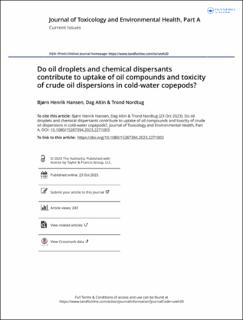| dc.contributor.author | Hansen, Bjørn Henrik | |
| dc.contributor.author | Altin, Dag | |
| dc.contributor.author | Nordtug, Trond | |
| dc.date.accessioned | 2024-02-19T11:46:30Z | |
| dc.date.available | 2024-02-19T11:46:30Z | |
| dc.date.created | 2023-11-06T10:49:08Z | |
| dc.date.issued | 2023 | |
| dc.identifier.citation | Journal of Toxicology and Environmental Health, Part A. 2023, . | en_US |
| dc.identifier.issn | 1528-7394 | |
| dc.identifier.uri | https://hdl.handle.net/11250/3118426 | |
| dc.description.abstract | Accidental crude oil spills to the marine environment cause dispersion of oil into the water column through the actions of breaking waves, a process that can be facilitated using chemical dispersants. Oil dispersions contain dispersed micron-sized oil droplets and dissolved oil components, and the toxicity of oil dispersions has been assumed to be associated primarily with the latter. However, most hydrophobic, bioaccumulative and toxic crude oil components are retained within the droplets which may interact with marine filter-feeders. We here summarize the findings of 15 years of research using a unique methodology to generate controlled concentrations and droplet size distributions of dispersed crude oil to study effects on the filter-feeding cold-water copepod Calanus finmarchicus. We focus primarily on the contribution of chemical dispersants and micron-sized oil droplets to uptake and toxicity of oil compounds. Oil dispersion exposures cause PAH uptake and oil droplet accumulation on copepod body surfaces and inside their gastrointestinal tract, and exposures to high exposure (mg/L range) reduce feeding activity, causes reproductive impairments and mortality. These effects were slightly higher in the presence of chemical dispersants, possibly due to higher filtration of chemically dispersed droplets. For C. finmarchicus, dispersions containing oil droplets caused more severe toxic effects than filtered dispersions, thus, oil droplets contribute to the observed toxicity. The methodology for generating crude oil dispersion is a valuable tool to isolate impacts of crude oil microdroplets and can facilitate future research on oil dispersion toxicity and produce data to improve oil spill models. | en_US |
| dc.language.iso | eng | en_US |
| dc.publisher | Taylor and Francis Group | en_US |
| dc.rights | Navngivelse 4.0 Internasjonal | * |
| dc.rights.uri | http://creativecommons.org/licenses/by/4.0/deed.no | * |
| dc.title | Do oil droplets and chemical dispersants contribute to uptake of oil compounds and toxicity of crude oil dispersions in cold-water copepods? | en_US |
| dc.title.alternative | Do oil droplets and chemical dispersants contribute to uptake of oil compounds and toxicity of crude oil dispersions in cold-water copepods? | en_US |
| dc.type | Journal article | en_US |
| dc.type | Peer reviewed | en_US |
| dc.description.version | publishedVersion | en_US |
| dc.source.pagenumber | 18 | en_US |
| dc.source.journal | Journal of Toxicology and Environmental Health, Part A | en_US |
| dc.identifier.doi | 10.1080/15287394.2023.2271003 | |
| dc.identifier.cristin | 2192476 | |
| dc.relation.project | Norges forskningsråd: 315969 | en_US |
| cristin.ispublished | true | |
| cristin.fulltext | original | |
| cristin.qualitycode | 1 | |

